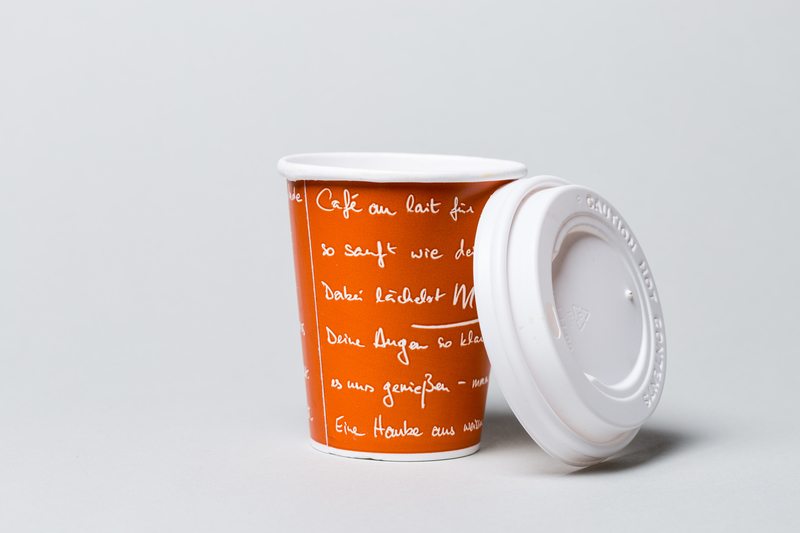In the Greenpeace office this week we’ve been arguing over which recycling bin to toss our coffee cups into. While most people take their own mug to the cafe, there are a few people that forget, causing much consternation to the office zealots who find the cups strewn between the plastics, paper, and compost bin.

Product shots of plastic products versus products made out of alternative material.
Produktfotos von Plastikprodukten fuer das Greenpeace Memory-Spiel.
Kaffeebecher mit Plastikdeckel.
Someone piped up that polystyrene is in fact recyclable, another said that paper cups are covered with a plastic film which makes them unable to be recycled as paper, and someone else suggested buying those paper cups with a biodegradable film, prompting the response that these can’t be recycled and go to landfill anyway.
So what do we do with all these coffee cups? Whilst this may not be the greatest moral dilemma of our time, it is significant – literally billions of coffee cups of coffee cups are dumped in landfill every year.
At that point, our resident scientist weighed in and told us where to shove our cups.
What’s the answer to our coffee cup dilemma?
He effectively ended the argument so I thought I’d share what he said:
Hi all,
Sorry to nitpick, but I feel it’s important to clarify the situation on polystyrene – it’s something I’ve been asked about a number of times.
We should not buy the plastic industry’s line on the recycling of polystyrene or most other plastics for that matter. This is an important, current issue as industry has been responsible for a significant erosion of the definition of the term recycling.
Polystyrene may be collected (if used in bulk applications; big factories not dispersed applications such as coffee cups) and used for a number of dubious applications (stirring plastic into soil for aeration anyone?) or melted down to make lower quality plastic products but it is not turned back into a fresh coffee cup. Therefore it is not recycled. Every plastic coffee cup used is made of virgin polymer; “recycling” does not reduce the quantity of oil used to make new coffee cups.
A related rant: don’t buy into these dodgy biodegradable eco cups (they’re largely made of GM corn and perpetuate the existing consumption paradigm) – NatureWorks, one of the biggest players, is owned by Cargill, one of the biggest corporations pushing GM food onto the world.
The only sure-fire way to increase the sustainability of your consumption habits is to reduce them.
Best,
Adam
So what’s the solution? Use a reusable cup.
And in case you or someone else in your office brings in a single use coffee cup – here’s what to do:
Find out who your recycling company is and talk to them about their specifications for recycling. Maybe they need you to separate waxed coffee cups from their lids or don’t accept juice cartons with foil insides. Ensuring you know what bin to out your rubbish makes sure that nothing ends up at the dump when it could be made into something else.
What else can you do?
Using less plastic and learning about recycling might not sound like a lot of fun, but it could save a turtle’s life. Here are 10 practical and achievable things you can start doing right now to cut down your plastic use and help prevent the senseless death of marine animals:
- Sign the petition to state premiers around the country yet to sign onto a Cash for Containers scheme and demand they step up to stop litter.
- Learn more about plastics and how to recycle them. This blog will take you through what you can and can’t recycle, and other organisations like Planet Ark have great learning resources to help guide you.
- Teach your friends and family about the importance of proper recycling. More people would think twice about littering if they knew the consequences plastic pollution has on our waterways, oceans and marine life. Share the information you find and try to positively influence the consumption and recycling habits of those around you.
- Join an initiative to help clean up your local area. Whether it’s participating in the annual Clean Up Australia Day or joining a Responsible Runners group – there are lots of ways you can have fun and curb plastic pollution at the same time.
- Or, if you’d prefer, fly solo and join the Take3 challenge: pick up three pieces of litter from your local beach, river, park or street every day.
- Check the products you buy for microbeads. Often the use of microbeads – tiny plastic beads found in many cosmetics and toiletries – is advertised, but they can also be hiding in the ingredients list. Luckily, the folks at Beat the Microbead have made an app to help you find out if these tiny pollutants are in your favourite products.
- Remember to bring your reusable containers with you. Cloth shopping bags, stainless steel water bottles and travel mugs are great – as long as you’ve got them with you when you need them.
- Opt out of disposable plastics when you’re eating out. Doing things like bringing your own container and recyclable or compostable cutlery for take-out meals and saying no to straws may seem strange, but it’ll help you cut down on one-use plastics.
- Think about excess packaging whenever you’re making purchases. Try to veer towards foods and goods packaged in paper or other recyclable materials rather than plastic wrapping – or better yet, nothing at all! You can read here about Berlin’s new no-packaging supermarket!
- For the brave: go plastic free! Life without plastic can be difficult, and expensive, but if you have the dedication it’s a worthy challenge. Read about the path to a plastic free life in the Life Without Plastic and My Plastic Free Life blogs.
[optin-monster-shortcode id=”yvqepuxvguhcvfh22aie”]


